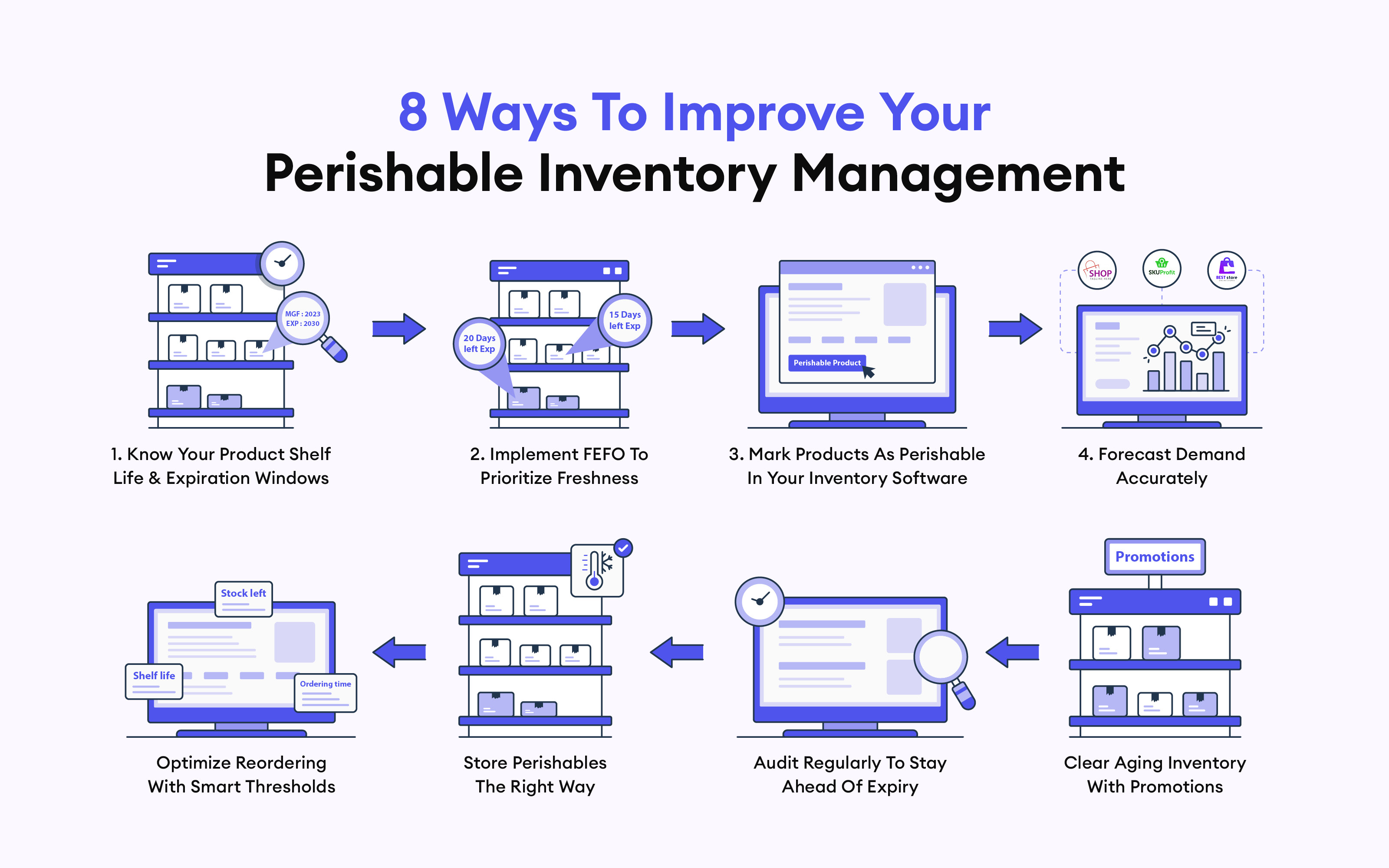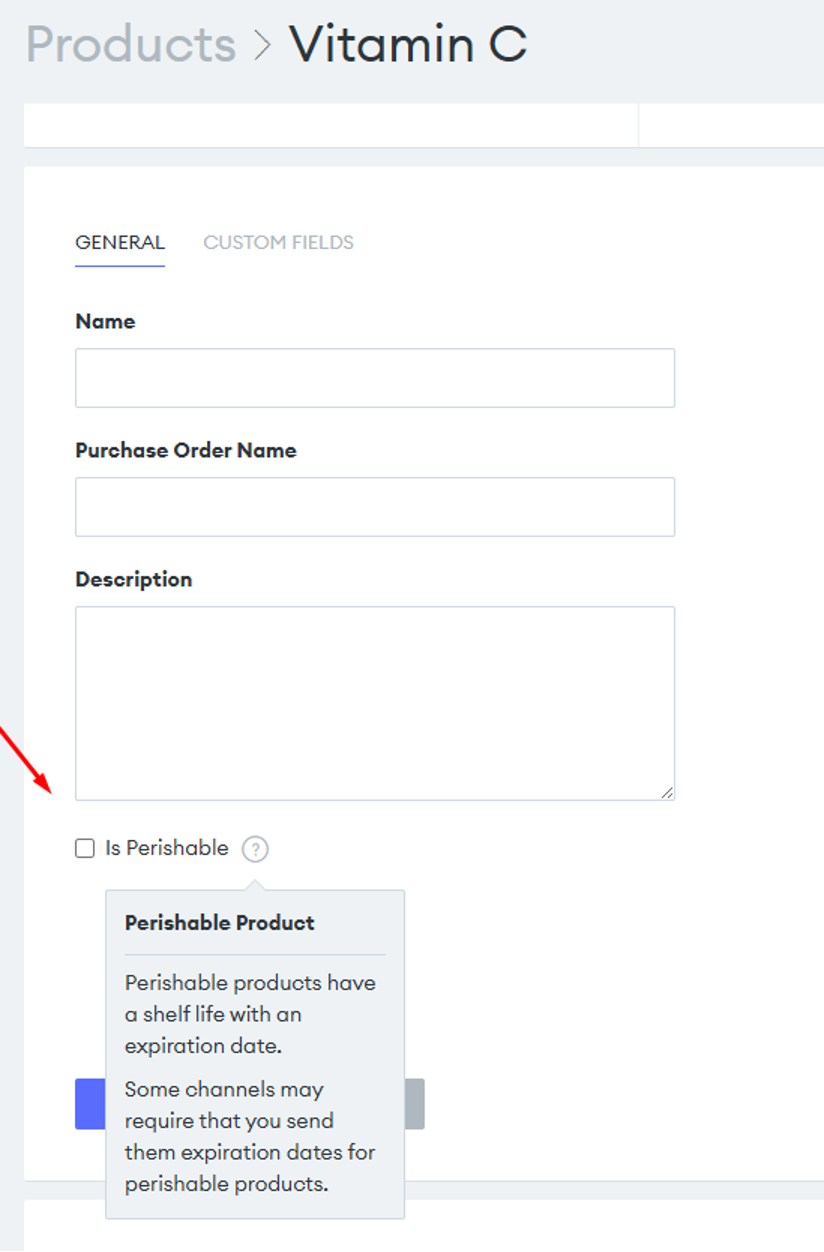Managing Perishable Inventory: How To Keep Things Fresh & Avoid Waste

In the world of ecommerce, there are some products that have a ticking clock on their shelf life.
After all, no one wants to receive wilted flowers, expired supplements, or cosmetics past their best-before date.. Unlike items like books and furniture, which could sit on a warehouse shelf for years, time-sensitive inventory comes with unique challenges.
If your ecommerce business handles any perishable inventory, you’ll need to take a smarter, more proactive approach than standard inventory practices, so you can avoid spoilage, compliance concerns, lost revenue and disappointed customers when things arrive past their prime.
In this post, we’ll walk you through practical, proven tactics you can use to keep your products fresh, your customers happy and your operations running smoothly.
8 Ways To Improve Your Perishable Inventory Management

1. Know Your Product Shelf Life & Expiration Windows
In order to manage your perishable products, you’ll need to know when they become unusable, and that starts with understanding their shelf life and sell-by or use-by dates. Shelf life refers to how long a product stays usable, while sell-by/use-by dates indicate when it should be sold or consumed for best quality.
Not all perishables need to move at the same pace. Fresh food and flowers will only last a few days, while supplements and cosmetics could sit on the shelves for months. Identifying fast-moving vs. slow-moving perishables helps you prioritize what needs closer attention.
Make sure your inventory system is set up to reflect this. Categorizing products by shelf life allows for better tracking, planning and reporting.
2. Implement FEFO To Prioritize Freshness
Ecommerce businesses that sell perishable items should be using the FEFO strategy for their inventory management, which stands for First-Expiring, First-Out. This means you’ll always prioritize inventory with the earliest expiration date, ensuring the highest level of freshness.
This is similar to the FIFO method, but in this case it’s the expiry date, not the date received, that determines what gets sold first.In some situations, this stock rotation strategy may be required by law.
For example, there are GDP Guidelines in the European Union that specify that “stock should be rotated according to the “first expiry, first out” (FEFO) principle. Exceptions should be documented.”
To learn more about methods of stock rotation and how to apply them to your inventory, check out our blog post Mastering Stock Rotation: A Guide to FIFO, LIFO and FEFO For Ecommerce Sellers.
3. Mark Products As Perishable In Your Inventory Software
Using your inventory software to keep track of which items are perishable is a very smart move that will help you to run your ecommerce business more effectively.
Goflow doesn’t currently support adding expiration dates to every product, as this requires serialized inventory. (It’s on the roadmap though!) While full expiration tracking requires serialized inventory, there’s still a quick win: flagging items as perishable in your product catalog.
Once marked as perishable, Goflow will automatically prompt you to enter the expiration date when shipping those products to channels that require it. This helps ensure compliance without adding friction to your workflow.
The “Is Perishable” toggle is right below the “Description” field in the “General” product information screen within your Product Catalog.

4. Forecast Demand Accurately
One of the biggest contributors to waste? Over-ordering. But under-ordering hurts, too. It leads to stockouts, missed sales, and unhappy customers.
Accurate demand forecasting is the secret to hitting the sweet spot. When you use an inventory tool like Goflow, you can pull data from across all your sales channels to deliver a real-time, unified view, so your predictions are never based on guesswork. You’ll be able to use historical sales data, seasonal trends, and upcoming promotions to plan smarter.
Need help improving your forecasting game? Read our Inventory Forecasting Guide.
5. Optimize Reordering With Smart Thresholds
Figuring out when to reorder your products can be tricky. You want to hit the right balance: just enough buffer to avoid stockouts, but not so much that items expire on your shelves.
The ideal strategy is to set par levels and reorder points within your inventory management software that are based on each product’s shelf life and your supplier’s lead times. Then, use automation to trigger reorders as needed, eliminating human error and freeing your team to focus on growth.
6. Store Perishables The Right Way
Even the best forecasting and reordering won’t save you if products are stored incorrectly. Temperature, humidity, and lighting all play a role in extending shelf life and preventing spoilage. There may even be specific laws in your country about maintaining a continuous refrigerated chain from production to consumption, ensuring that the product is always kept below a certain temperature to prevent spoilage and protect customer safety.
Set up dedicated zones in your warehouse for perishable items and train your team on proper handling. Something as simple as leaving a box in the wrong place could shorten a product’s lifespan by days, or more - and put your company legally at risk.
7. Audit Regularly To Stay Ahead Of Expiry
Stay proactive in your inventory management by running frequent inventory audits or cycle counts that focus specifically on aging stock. If you wait until something is already expiring, it’s too late.
The good news is, with Goflow, you can run real-time stock aging reports and stay ahead of product life cycles. These reports highlight which products are approaching expiration, giving you time to act before losses occur.
8. Clear Aging Inventory With Promotions
Sometimes, despite your best forecasting and storage efforts, certain items will get a little too close to their expiration date for comfort. When that happens, promotions can be a great way to move aging stock quickly and reduce waste.
You can offer “short-dated” items at a discount to your most loyal customers, run flash sales, or create last-minute bundles that make use of perishable items nearing their sell-by date. It helps you clear shelves, avoid spoilage, and give customers a chance to score a deal. Win-win!
Just be sure to clearly communicate expiration dates in your product listings so customers know what they’re getting. Transparency builds trust, especially when selling perishable goods.
Keep Things Fresh With These Perishable Inventory Tips
Managing perishable inventory isn’t just about avoiding waste. It’s about running a smarter, leaner, and more resilient ecommerce operation. With the right systems and processes in place, you can keep your products fresh, your compliance boxes checked, and your customers delighted with every delivery.
Tools like Goflow can help by giving you greater visibility into expiration windows, automating reordering logic, prompting expiration date inputs when needed, and surfacing real-time reports to help you stay ahead of spoilage.
Ready to simplify perishable inventory management? Schedule a demo and see how Goflow helps ecommerce businesses streamline operations and scale with confidence.
